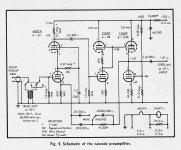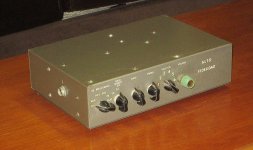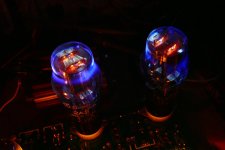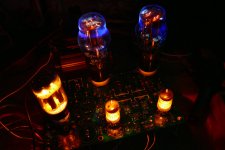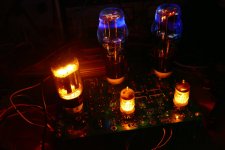And in many the input signal was applied to the cathode of the lower tube to better match the driving transmission line, 50R. 75R, 300R & so on.So . . . enter the dual triode cascode circuit (boy, those early engineers were genius - again and again).
And the grid formed an effective electrostatic shield between the input & out put circuits, less possibility of oscillation due
to parasitic s in the circuit. But that is a whole different World.
jhstewart9,
I agree.
Sometimes you do not need to use a cascode stage. You can get a very low noise figure RF amplifier with only a single triode.
Example: A 416A triode grounded grid amplifier.
I bet you have either seen the schematic of that, or seen a receiver that uses one . . . or both.
I agree.
Sometimes you do not need to use a cascode stage. You can get a very low noise figure RF amplifier with only a single triode.
Example: A 416A triode grounded grid amplifier.
I bet you have either seen the schematic of that, or seen a receiver that uses one . . . or both.
By chance I've got two WE 416Bs in my desk. They were manufactured here in Canada, probably Toronto.
So I guess they are NE416Bs, made by Northern Telecom, the Canadian subsidiary of WE.
At one time NE was my largest account. That was during the period I was pushing the HP semiconductor products, mostly LEDs.
I built a low noise preamp with a BQ7 cascode front end. Circa 1958. Still here on the shelf! 👍
So I guess they are NE416Bs, made by Northern Telecom, the Canadian subsidiary of WE.
At one time NE was my largest account. That was during the period I was pushing the HP semiconductor products, mostly LEDs.
I built a low noise preamp with a BQ7 cascode front end. Circa 1958. Still here on the shelf! 👍
Attachments
45,
Thanks again for your 2A3 curves versus load resistance.
It is very revealing.
(And for all of those who can and will read through this long dissertation):
If I read it correctly, then with a varying load range, we get:
6000 to 4000 Ohms; 2nd Harmonic Distortion 2% to 2.6%, Power 2.2 Watts to 2.8 Watts
4000 to 2500 Ohms; 2nd Harmonic Distortion 2.6% to 4.4%, Power 2.8 Watts to 3.7 Watts
2500 to 1250 Ohms; 2nd Harmonic Distortion 4.4% to 9%, Power 3.7 Watts to 5 Watts
The classic load for a single ended 2A3 is 2500 Ohms.
Let us use a 2500 Ohm to 8 Ohm output transformer, and some models of "8 Ohm" rated loudspeaker:
That "8 Ohm" loudspeaker impedance may vary from 4 Ohms to 19.2 Ohms over the 20 to 20kHz frequency range.
The result is the 2A3 2nd harmonic distortion ranges from 2% to 9% into that loudspeaker.
If a driver's 2nd harmonic distortion is 2%, there is Good Cancellation of the 2A3's 2nd harmonic distortion of 2% when the loudspeaker is 19.2 Ohms.
The same driver's 2nd harmonic distortion of 2%, there is Very Little Cancellation of the 2A3's 2nd harmonic distortion of 9% when the loudspeaker is 4 Ohms.
That kind of proves my stipulation that the 2nd harmonic cancellation can be all over the map.
Given the same "8 Ohm" loudspeaker impedance that varies from 4 Ohms to 19.2 Ohms, there are at least a couple of solutions:
1. Use a 5000 Ohm primary transformer.
You can read the graphs and see the improvement of 2nd harmonic distortion, which gives better 2nd harmonic cancellation with the same loudspeaker and the same driver,
(A 5000 Ohm primary, gives a reflected load of 2500 Ohms to 12,000 Ohms with the same loudspeaker).
Do not worry that anything over 6000 Ohms is off the 2A3 chart . . .
The 2A3 2nd harmonic distortion either stays the same, or improves versus the 6000 Ohm load.
A 2500 Ohm transformer and 5000 Ohm transformer can be about the same price.
The tradeoff is, in order to get better 2nd harmonic distortion cancellation, you will get lower power out.
2. Modify the loudspeaker with multiple Series LCR zobel networks to flatten the impedance across the 20 to 20k frequency range.
The disadvantages are resonators that can ring (whatever the Q), more parts, more expense, and . . .
Power lost in the LCRs.
Conclusion:
Either loose output power from the amplifier,
Or, loose power in the speaker LCRs.
2nd harmonic distortion cancellation?
No, because . . .
We are given loudspeakers with wide impedance variations versus frequency.
I am not chasing that rabbit down the rabbit hole.
Thanks for "listening" (reading) Everybody!
Just my opinions
Thanks again for your 2A3 curves versus load resistance.
It is very revealing.
(And for all of those who can and will read through this long dissertation):
If I read it correctly, then with a varying load range, we get:
6000 to 4000 Ohms; 2nd Harmonic Distortion 2% to 2.6%, Power 2.2 Watts to 2.8 Watts
4000 to 2500 Ohms; 2nd Harmonic Distortion 2.6% to 4.4%, Power 2.8 Watts to 3.7 Watts
2500 to 1250 Ohms; 2nd Harmonic Distortion 4.4% to 9%, Power 3.7 Watts to 5 Watts
The classic load for a single ended 2A3 is 2500 Ohms.
Let us use a 2500 Ohm to 8 Ohm output transformer, and some models of "8 Ohm" rated loudspeaker:
That "8 Ohm" loudspeaker impedance may vary from 4 Ohms to 19.2 Ohms over the 20 to 20kHz frequency range.
The result is the 2A3 2nd harmonic distortion ranges from 2% to 9% into that loudspeaker.
If a driver's 2nd harmonic distortion is 2%, there is Good Cancellation of the 2A3's 2nd harmonic distortion of 2% when the loudspeaker is 19.2 Ohms.
The same driver's 2nd harmonic distortion of 2%, there is Very Little Cancellation of the 2A3's 2nd harmonic distortion of 9% when the loudspeaker is 4 Ohms.
That kind of proves my stipulation that the 2nd harmonic cancellation can be all over the map.
Given the same "8 Ohm" loudspeaker impedance that varies from 4 Ohms to 19.2 Ohms, there are at least a couple of solutions:
1. Use a 5000 Ohm primary transformer.
You can read the graphs and see the improvement of 2nd harmonic distortion, which gives better 2nd harmonic cancellation with the same loudspeaker and the same driver,
(A 5000 Ohm primary, gives a reflected load of 2500 Ohms to 12,000 Ohms with the same loudspeaker).
Do not worry that anything over 6000 Ohms is off the 2A3 chart . . .
The 2A3 2nd harmonic distortion either stays the same, or improves versus the 6000 Ohm load.
A 2500 Ohm transformer and 5000 Ohm transformer can be about the same price.
The tradeoff is, in order to get better 2nd harmonic distortion cancellation, you will get lower power out.
2. Modify the loudspeaker with multiple Series LCR zobel networks to flatten the impedance across the 20 to 20k frequency range.
The disadvantages are resonators that can ring (whatever the Q), more parts, more expense, and . . .
Power lost in the LCRs.
Conclusion:
Either loose output power from the amplifier,
Or, loose power in the speaker LCRs.
2nd harmonic distortion cancellation?
No, because . . .
We are given loudspeakers with wide impedance variations versus frequency.
I am not chasing that rabbit down the rabbit hole.
Thanks for "listening" (reading) Everybody!
Just my opinions
Last edited:
+1 on that! Single stage 300B is very good with a 417A, 5842, 6S45P, WE437, etc... The best sounding 300B Amp I've heard to date is the Border Patrol S20 a PSE, single stage input 6S45P, interstage, with huge dual mono choke input supplies. That Amp combined with the 100db horn Volti Audio Rival speakers, beautiful sound, from somewhat affordable speakers. Having heard hundreds of 300B amps over the years, my first 300B build will definitely be an attempt using a single stage RF tube like 417A, but more likely 6S45P since I have those.
Last edited:
Hi 6A3sUMMER
This is why I always used an OPT with at least 3.5k ohm (or 5K) primary for OPT for 2a3 (for single ended). 2nd order harmonic distortion always increases with power, and I was always happy to measure only 2% at 2W output( for single ended operation).
What was all over the map was what each 2a3 might measure. I have at around 50 2a3 examples, ranging from cheap ones made in China, to Russian ones (Sovtek) and of course the ubiquitous vintage USA made ones. Generally speaking the USA 2a3's from the 1950's (earliest ones I have and also most expensive) had the lowest distortion. BUT I had the odd Russian or even cheap China one that exhibited low distortion too.
Distortion was naturally lower for PP configurations for the power produced. If you need more power, and want to keep distortion low, the better option is to go for a PP configuration.
If the loudspeakers are sensitive enough, and you don't need more than say 1W power, I strongly suggest the 45 tube... PP 45 is also really nice too btw.
Ian
45,
You mentioned the difference in core loss of single ended air gapped transformer with DC applied, versus push pull transformers.
(pp transformers, often with essentially no air gap, when considered as a ratio of the "thickness" of the air between interleaved Is and Es on a push pull transformer, versus the air gap "thickness" of an se tramsformer).
Well, thanks for that!
It reminded me of the dual channel se amplifier I built 20 to 25 years ago:
I took the signal from a single channel (Left) of a CD player; then I ran it through a phase inverter.
I put the in-phase signal to channel 1; I put the out-of-phase signal to channel 2.
Then I connected the two se output transformers secondaries in 'anti-parallel'.
Ch1 8 to Ch2 Common; Ch1 Common to Ch2 8.
This 2 channel se amp became a 1 channel push pull monoblock
Because of the se transformers, the air gap, and the (un-balanced) DC in the primary . . .
Just as you said: the core has less loss, and the flux never goes to zero.
Very few people understand this pseudo push pull circuit.
I thought I had invented something new, I was wrong . . .
I found out the French were already doing that.
Anybody that does not like this design needs to blame the French, do not blame me.
You mentioned the difference in core loss of single ended air gapped transformer with DC applied, versus push pull transformers.
(pp transformers, often with essentially no air gap, when considered as a ratio of the "thickness" of the air between interleaved Is and Es on a push pull transformer, versus the air gap "thickness" of an se tramsformer).
Well, thanks for that!
It reminded me of the dual channel se amplifier I built 20 to 25 years ago:
I took the signal from a single channel (Left) of a CD player; then I ran it through a phase inverter.
I put the in-phase signal to channel 1; I put the out-of-phase signal to channel 2.
Then I connected the two se output transformers secondaries in 'anti-parallel'.
Ch1 8 to Ch2 Common; Ch1 Common to Ch2 8.
This 2 channel se amp became a 1 channel push pull monoblock
Because of the se transformers, the air gap, and the (un-balanced) DC in the primary . . .
Just as you said: the core has less loss, and the flux never goes to zero.
Very few people understand this pseudo push pull circuit.
I thought I had invented something new, I was wrong . . .
I found out the French were already doing that.
Anybody that does not like this design needs to blame the French, do not blame me.
I normally use 2.5K for the lowest impedance I want to drive. For example, if my speakers have 5R minimum impedance I use a standard 4K/8R Etc.45,
Thanks again for your 2A3 curves versus load resistance.
It is very revealing.
(And for all of those who can and will read through this long dissertation):
If I read it correctly, then with a varying load range, we get:
6000 to 4000 Ohms; 2nd Harmonic Distortion 2% to 2.6%, Power 2.2 Watts to 2.8 Watts
4000 to 2500 Ohms; 2nd Harmonic Distortion 2.6% to 4.4%, Power 2.8 Watts to 3.7 Watts
2500 to 1250 Ohms; 2nd Harmonic Distortion 4.4% to 9%, Power 3.7 Watts to 5 Watts
The classic load for a single ended 2A3 is 2500 Ohms.
Let us use a 2500 Ohm to 8 Ohm output transformer, and some models of "8 Ohm" rated loudspeaker:
That "8 Ohm" loudspeaker impedance may vary from 4 Ohms to 19.2 Ohms over the 20 to 20kHz frequency range.
The result is the 2A3 2nd harmonic distortion ranges from 2% to 9% into that loudspeaker.
If a driver's 2nd harmonic distortion is 2%, there is Good Cancellation of the 2A3's 2nd harmonic distortion of 2% when the loudspeaker is 19.2 Ohms.
The same driver's 2nd harmonic distortion of 2%, there is Very Little Cancellation of the 2A3's 2nd harmonic distortion of 9% when the loudspeaker is 4 Ohms.
That kind of proves my stipulation that the 2nd harmonic cancellation can be all over the map.
Given the same "8 Ohm" loudspeaker impedance that varies from 4 Ohms to 19.2 Ohms, there are at least a couple of solutions:
1. Use a 5000 Ohm primary transformer.
You can read the graphs and see the improvement of 2nd harmonic distortion, which gives better 2nd harmonic cancellation with the same loudspeaker and the same driver,
(A 5000 Ohm primary, gives a reflected load of 2500 Ohms to 12,000 Ohms with the same loudspeaker).
Do not worry that anything over 6000 Ohms is off the 2A3 chart . . .
The 2A3 2nd harmonic distortion either stays the same, or improves versus the 6000 Ohm load.
A 2500 Ohm transformer and 5000 Ohm transformer can be about the same price.
The tradeoff is, in order to get better 2nd harmonic distortion cancellation, you will get lower power out.
2. Modify the loudspeaker with multiple Series LCR zobel networks to flatten the impedance across the 20 to 20k frequency range.
The disadvantages are resonators that can ring (whatever the Q), more parts, more expense, and . . .
Power lost in the LCRs.
Conclusion:
Either loose output power from the amplifier,
Or, loose power in the speaker LCRs.
2nd harmonic distortion cancellation?
No, because . . .
We are given loudspeakers with wide impedance variations versus frequency.
I am not chasing that rabbit down the rabbit hole.
Thanks for "listening" (reading) Everybody!
Just my opinions
Second, the 15W limit for a well made 2A3 is conservative. In the mid 90s in Italy there was a famous kit with the 2A3 running the tube at 16.5W (275V/60mA with 3K/6R OPT). They sold many, it was even used in magazine reviews of commercial loudspeakers. None of them has ever been reported as faulty.
I have done it myself as well for a friend of mines and can guarantee that measuring gm after about 5K it was the same and emission some 5% lower..... These were Chinese Golden Dragon. The Russian 6C4C is even better and can run at 18W without a problem. As per datasheet, it can take up to 360V anode voltage.
Getting 5W into lowest load and 4W on average is no brainer. I suggest you build yourself instead of speculating.
P.S.
I can also suggest to do the following experiment with a good double-plate 2A3/6A3/6B4G. Run it at 25W plate dissipation for a couple of hours! It won't turn a hair: No red plate, no change in parameters, no runaway, nothing at all. After that you will be able to use it like nothing has happened.
Don't do it with a single plate both original or recent 300B-like tubes tough. Those don't stand a chance.
I can also suggest to do the following experiment with a good double-plate 2A3/6A3/6B4G. Run it at 25W plate dissipation for a couple of hours! It won't turn a hair: No red plate, no change in parameters, no runaway, nothing at all. After that you will be able to use it like nothing has happened.
Don't do it with a single plate both original or recent 300B-like tubes tough. Those don't stand a chance.
I dug out an old TSE-II board to test some alternative filament regulators to use in place of the hard to get MIC29502's. The board was set up for 300B's which were tested and worked fine. I then changed the voltage set resistor in the regulator to generate 2.5 volts and plugged in some 20 year old Shuguang 2A3's. What would 2A3's do on 400 volts of B+?
They ROCK, that's what. I ran them at 65 mA with an actual plate voltage of about 390 volts using a 3000 ohm Toroidy OPT. This is a dissipation of 25.4 watts. I liked the way they sounded well enough to leave it set up on the bench for several weeks until I needed to put an UNSET board back on the bench. The tubes were rock solid after about an hour of run time as I never had to touch the bias pots after that.
Ever see blue fluorescence on the glass of a DHT?
They ROCK, that's what. I ran them at 65 mA with an actual plate voltage of about 390 volts using a 3000 ohm Toroidy OPT. This is a dissipation of 25.4 watts. I liked the way they sounded well enough to leave it set up on the bench for several weeks until I needed to put an UNSET board back on the bench. The tubes were rock solid after about an hour of run time as I never had to touch the bias pots after that.
Ever see blue fluorescence on the glass of a DHT?
Attachments
I have some cheap china 2a3's that all have that blue glow. I got them all for FREE from a friend who does audiophool upgrades. 😉
Despite being of 'budget' heritage, (1990's China) most of them are VERY GOOD so long as you run them with high enough plate voltage.
The Blue Glow is very eye-catching at night!
Despite being of 'budget' heritage, (1990's China) most of them are VERY GOOD so long as you run them with high enough plate voltage.
The Blue Glow is very eye-catching at night!
45,
Thanks!
It is interesting that you pick a minimum impedance of 2.5k.
A 5 Ohm loudspeaker on a 4k to 8 Ohm loudspeaker presents a 2500 Ohm load to the 2A3.
And, in the 2A3 data sheet, the Classic load for a single ended 2A3 is 2500 Ohms.
But what happens if the 5 Ohm rated loudspeaker has a minimum impedance of 3 Ohms, for example?
If you use a 2.5k primary transformer on a 2A3, you might have Extra 2nd harmonic distortion
(which many of us love, some do not, some do not hear the difference).
I have used a number of 8 Ohm rated loudspeakers that have a minimum impedance of 6 Ohms.
Look at what happens when a 2.5k to 8 ohm transformer, and an "8 Ohm rated" loudspeaker's minimum impedance is only 6 Ohms, for those who decide to use the Classic 2500 Ohm primary:
The 2A3 will see a 6/8 x 2500 Ohms = 1875 Ohm load, when a speaker's minimum impedance of 6 Ohms is connected to the 8 Ohm tap.
Your curve shows 2nd harmonic distortion at 1875 Ohms, of about 6% (at the minimum impedance of 6 Ohms).
It is even worse for 8 Ohm rated loudspeakers that only have 4 or 5 Ohm minimum impedance.
Ouch! (for the people who do not want high 2nd harmonic distortion).
Example:
The natural sound of both a Clarinet, and a Bass Clarinet have Dominant 3rd harmonic (not distortion, it is the natural characteristic of that Clarinet sound).
What I do not want my amplifier to do is have 6% 2nd harmonic distortion, it could mask and cover up the Clarinet's natural dominant 3rd harmonic; Just like the sound we hear in a live concert.
Just my opinions
Note: I have designed and built single ended 2A3 amplifiers that used 5k primary transformers.
Less power out, but sounded real good.
Thanks!
It is interesting that you pick a minimum impedance of 2.5k.
A 5 Ohm loudspeaker on a 4k to 8 Ohm loudspeaker presents a 2500 Ohm load to the 2A3.
And, in the 2A3 data sheet, the Classic load for a single ended 2A3 is 2500 Ohms.
But what happens if the 5 Ohm rated loudspeaker has a minimum impedance of 3 Ohms, for example?
If you use a 2.5k primary transformer on a 2A3, you might have Extra 2nd harmonic distortion
(which many of us love, some do not, some do not hear the difference).
I have used a number of 8 Ohm rated loudspeakers that have a minimum impedance of 6 Ohms.
Look at what happens when a 2.5k to 8 ohm transformer, and an "8 Ohm rated" loudspeaker's minimum impedance is only 6 Ohms, for those who decide to use the Classic 2500 Ohm primary:
The 2A3 will see a 6/8 x 2500 Ohms = 1875 Ohm load, when a speaker's minimum impedance of 6 Ohms is connected to the 8 Ohm tap.
Your curve shows 2nd harmonic distortion at 1875 Ohms, of about 6% (at the minimum impedance of 6 Ohms).
It is even worse for 8 Ohm rated loudspeakers that only have 4 or 5 Ohm minimum impedance.
Ouch! (for the people who do not want high 2nd harmonic distortion).
Example:
The natural sound of both a Clarinet, and a Bass Clarinet have Dominant 3rd harmonic (not distortion, it is the natural characteristic of that Clarinet sound).
What I do not want my amplifier to do is have 6% 2nd harmonic distortion, it could mask and cover up the Clarinet's natural dominant 3rd harmonic; Just like the sound we hear in a live concert.
Just my opinions
Note: I have designed and built single ended 2A3 amplifiers that used 5k primary transformers.
Less power out, but sounded real good.
Last edited:
If you have some harmonic cancellation your distortion will be lower even if you use with 2.5K/8R transformer. With some 6 dB cancellation THD will be 3% when load is down to 1875R, so to say. This is just a simplistic reasoning, just to make the point but if one gets it right the overall distortion of the amplifier will be less than without cancellation. If used without abuses, which mostly means the driver tube is well behaved, with low distortion at low-to-medium levels and with largely dominant 2H when reaching max Pout, overall 2H will be lower and the rest of the spectrum will remain basically unaffected.
Simple SE: 1/2 E80CC + 2A3. Voltage supply 295V + drop in the primary of the OT. Run the 2A3 like in datasheet with 2K5/8R at 250V/60mA with cathode bias + 220K grid resistor. For the E80CC, from about 300-305 V supply you have some 10-15 V to use in more filtering and then use 56K anode resistor and 1.5K bypassed cathode resistor. At 30V rms out the E80CC THD will be about 2-2.5% with 3rd harmonic at no worse than -50 dB and very little else. This worked out really well for me.
Simple SE: 1/2 E80CC + 2A3. Voltage supply 295V + drop in the primary of the OT. Run the 2A3 like in datasheet with 2K5/8R at 250V/60mA with cathode bias + 220K grid resistor. For the E80CC, from about 300-305 V supply you have some 10-15 V to use in more filtering and then use 56K anode resistor and 1.5K bypassed cathode resistor. At 30V rms out the E80CC THD will be about 2-2.5% with 3rd harmonic at no worse than -50 dB and very little else. This worked out really well for me.
Last edited:
In the mid 90s in Italy there was a famous kit with the 2A3 running the tube at 16.5W (275V/60mA with 3K/6R OPT). They sold many, it was even used in magazine reviews of commercial loudspeakers..
hi, can you share this project, please?
http://www2.audiokit.it/ITAENG/KitElettr/MEGA/Triodino/Triodino.htm
Voltage values in the brackets are for the 300B.
Voltage values in the brackets are for the 300B.
45,
Agreed, with 2 stages, input and 2A3 output, there will always be some cancellation of the 2nd harmonic distortion (lots, medium, or very little cancellation).
My main point is that the cancellation is variable, versus the load impedance. That is one main characteristic of a 2 stage single ended amplifier.
And for those of you who can remember, Glass Audio had a cover article, about a single ended 2A3 amplifier, called Kismet. It had about 17 watts dissipation in the plate, and custom high number of interleaved primary and secondary windings. Nice Amplifier!
I think the amplifier 'resided' in Italy.
The 2A3 is a great tube for SE and for Push Pull.
Happy designing, building, and listening!
Agreed, with 2 stages, input and 2A3 output, there will always be some cancellation of the 2nd harmonic distortion (lots, medium, or very little cancellation).
My main point is that the cancellation is variable, versus the load impedance. That is one main characteristic of a 2 stage single ended amplifier.
And for those of you who can remember, Glass Audio had a cover article, about a single ended 2A3 amplifier, called Kismet. It had about 17 watts dissipation in the plate, and custom high number of interleaved primary and secondary windings. Nice Amplifier!
I think the amplifier 'resided' in Italy.
The 2A3 is a great tube for SE and for Push Pull.
Happy designing, building, and listening!
Last edited:
My 300B-Z tubes blue glow like that around the tops.Ever see blue fluorescence on the glass of a DHT?
@6A3sUMMER, Your main point does not change the fact that distortion will be lower anyway than without cancellation, so output power IS more usable. At worst it will be the same distortion of an amp without cancellation. Any single ended amplifier will suffer a drop in loudspeaker load that is why I always pick the primary load based on minimum loudspeaker impedance. On the contrary ALL tube amps, regardless of the output topology, are fine with high impedance. In many cases even better than SS amps.
45,
Agreed, with 2 stages, input and 2A3 output, there will always be some cancellation of the 2nd harmonic distortion (lots, medium, or very little cancellation).
My main point is that the cancellation is variable, versus the load impedance. That is one main characteristic of a 2 stage single ended amplifier.
And for those of you who can remember, Glass Audio had a cover article, about a single ended 2A3 amplifier, called Kismet. It had about 17 watts dissipation in the plate, and custom high number of interleaved primary and secondary windings. Nice Amplifier!
I think the amplifier 'resided' in Italy.
The 2A3 is a great tube for SE and for Push Pull.
Happy designing, building, and listening!
Don’t have the issue handy but I recall it being a nice simple design with a 6DJ8 driver.
- Home
- Amplifiers
- Tubes / Valves
- Skunkie Designs 300B
